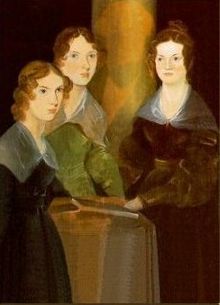Brontë siblings
Four 19th century British writers are known as the Brontë siblings , three sisters and their brother. The sisters published their works under male pseudonyms throughout their lives , while the brother published under his real name.
- Charlotte Brontë (1816–1855) (pseudonym: Currer Bell)
- Branwell Brontë (1817-1848)
- Emily Brontë (1818–1848) (pseudonym: Ellis Bell)
- Anne Brontë (1820–1849) (pseudonym: Acton Bell)
Life
The four siblings were the children of Pastor Patrick Brontë (1777–1861). As an amateur poet, the father occasionally published stories, poems and theological essays in mainly church magazines. Her mother Maria Branwell (1783-1821) died early, as did the older sisters Maria (1814-1825) and Elizabeth (1815-1825).
Maria Branwell's sister Elizabeth (1776–1842), called Aunt Branwell by the children, moved from Cornwall to Haworth and ran the family. The girls owed part of their upbringing to their aunt, and she also financed Charlotte and Emily's longer study visits to Brussels. For her nephew Branwell Brontë (1817–1848), who saw himself as an artist and writer, she seemed to represent a mother figure, because he mourned her death intensely.
In 1834 Branwell painted a portrait of the siblings. Since he was dissatisfied with his own portrait in the middle, he wiped out his representation afterwards. The portrait is on display today in the National Portrait Gallery in London , Trafalgar Square .
Branwell and Emily died in 1848, Anne in 1849 and Charlotte in 1855. In many (mainly older) biographies, tuberculosis is generally assumed to be the cause of death; recent biographical research, based on the then by Dr. McCracken, the family's general practitioner, named the death certificates for the following possible causes:
- Branwell died of bronchitis and kidney failure, the latter due to his alcoholism ; Chronic bronchitis marasmus is mentioned in the death certificate .
- Emily died of untreated full blown pneumonia ; Charlotte previously wrote in a letter to Ellen Nussey that Emily had pneumonia.
- Anne actually died of tuberculosis ; this was the diagnosis of a doctor from Leeds whom Patrick Brontë consulted.
- Charlotte died of hyperemesis gravidarum ; Phthisis nervosa is stated in the death certificate , an outdated term for the inability to ingest or keep food to oneself.
The Brontë family's home is now open to the public as a museum
plant
Together, inspired by Branwell's toy soldiers, the siblings invented fictional worlds for which they invented games and wrote stories and poems. After the siblings received art lessons, they also began drawing pictures to accompany their stories. The preoccupation with the fantasy worlds continued into young adulthood, whereby two pairs with their own "saga" formed during puberty :
- Angria (also called: Glasstown ) by Charlotte and Branwell
- Gondal from Emily and Anne
In later adult life the collaboration ended when the siblings separated physically for professional reasons. Emily and Anne carried on their joint fantasy work longest, the Gondal saga only ends when work on the manuscripts for their later published novels begins.
In 1846, the sisters published the poetry anthology Poems under male pseudonyms , but only two copies of the first edition were sold. Emily had rewritten some of her Gondal poems for the anthology. The sisters kept the pseudonyms for their later novel publications throughout their lives.
In 1899 a work by the three sisters was published for the first time under their real names by Harper & Brothers, New York.
literature
Poetry collection
- Poems by Acton, Currer and Ellis Bell, 1846
Secondary literature
- Juliet Barker: The Brontës . Weidenfeld & Nicolson, London 1994 ISBN 0-297-81290-4
- Paul Barker and James Birdsall: The World of the Brontës . Insel Verlag, Frankfurt 1997 ISBN 3-458-16881-8
- Elsemarie Maletzke: The life of the Brontës . btb, Berlin 1992 ISBN 3-442-72602-6
- Sally Schreiber: The Brontë siblings . dtv, Munich 1998 ISBN 3-423-31012-X
- Arno Schmidt : Angria & Gondal. The dream of the dove-gray sisters, in works, Vol. II / 2, Haffmans, Zurich 1990 ISBN 3-251-80018-3 , pp. 403-432
- Muriel Spark : In a storm-torn world. The Brontës (OT: The Essence of the Brontës ). Diogenes, Zurich 1993 ISBN 3-257-23555-0
-
Robert de Traz : La famille Brontë. Albin Michel, Paris 1939 a. ö.
- The Brontë family. A biography. Insel-Verlag , Frankfurt 1993 ISBN 3458332480
- Werner Waldmann: The Brontë sisters . Rowohlt, Hamburg 1990 ISBN 3-499-50456-1
Movie
The life of the Brontë sisters has been filmed several times, the most important ones being:
- 1943: Three Sisters Of The Moors - Production: Twentieth Century Fox
- 1946: Devotion - Production: Warner Bros., Starring: Olivia de Havilland , Ida Lupino , Arthur Kennedy , Nancy Coleman
- 1973: The Brontës of Haworth - Production: Yorkshire TV, Script: Christopher Fry ,
- 1979: The Brontë sisters ( Les Sœurs Brontë ) - director: André Techiné , actors: Isabelle Adjani , Isabelle Huppert , Marie-France Pisier
- 2016: To Walk Invisible - Production: BBC Cymru Wales, Direction: Sally Wainwright , Starring: Finn Atkins , Charlie Murphy , Adam Nagaitis, Chloe Pirrie , Jonathan Pryce
Web links
- Brontë Parsonage Museum, Haworth
- Timeline (by Bettina Licht )
- Excerpt from: Norgard Kohlhagen: You write like a man, Madame! to the Brontë sisters
- The Brontës (special from the literary magazine lettern.de )
- The Brontës' Reading

